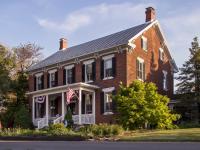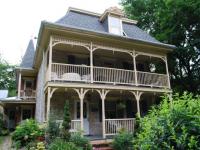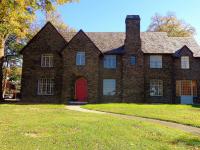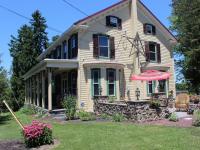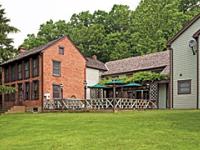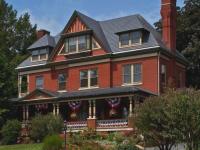You are here
From Rails to Trails
Miles of railroad track once spread like an intricately woven web across Pennsylvania connecting the tiniest towns to the largest cities and creating the framework for the largest transportation system in the world. By 1980, many lines were sold and abandoned. These same lines were transformed into greenway corridors to preserve a colorful part of our national heritage while creating scenic byways to promote outdoor recreation and tourism. In Pennsylvania, there are currently 144 rails-to-trails totaling over 900 miles.
Visit the trail website for access points.
South West
Great Allegheny Passage
The longest rail-trail east of the Mississippi River, the 150-mile trail spans two states in its course along great rivers and across mountain passes. Running from Pittsburgh, PA to Cumberland, MD, the Great Allegheny Passage traces the path of railroads that helped build America. Bicycling and hiking are the two most popular activities. The trail has a packed crushed limestone surface for a smooth ride. Built mainly on abandoned rail beds, the trail is nearly level with the average grade of less than 1%.
Westmoreland Heritage Trail
This crushed-limestone, multi-use rail-trail features reclaimed railroad bridges over the Conemaugh River and Loyalhanna Creek offering great views of the river hydraulics below. The trail runs along a section of the former Penn Central rail line and offers opportunities for bird watchers and other naturalists. The trail has a distinct uphill grade virtually the entire 5-mile length from Saltsburg to Slickville, offering a great opportunity for a quick downhill ride back to Saltsburg.
South Central
Cumberland Valley Rail Trail
Easy hiking and biking can be found along this 11-mile trail that follows the abandoned railroad tracks (former Cumberland Valley Railroad) from Shippensburg to Newville. The majority of the trail is a two-head trail with grassy, hard-packed earth perfect for equestrians and packed stone dust for hikers and bikers. In between the South Mountain and Blue Mountain ridges on the eastern flank of the Appalachians, this lush agricultural valley formed a travel corridor for Native Americans. The trail also features interpretive signage detailing the agricultural and historic significance of the trail and surrounding lands.
Ghost Town Trail
The trail derives its name from the numerous mining towns that once existed along the Ebensburg & Blacklick Railroad corridor. Mainly flat, the trail winds through scenic Blacklick Creek watershed, from Ebensburg to Grafton, passing historical artifacts and offering opportunities to see a variety of wildlife. The trail is a designated National Recreation Trail.
South East
Lebanon Valley Rail Trail
This 14.5-mile trail lets you experience the beauty of farmland and forest along the corridor of the old Cornwall-Lebanon Railroad. The trail features both a crushed stone path and parallel equestrian path surfaced with dirt and wood chips.
Perkiomen Trail
Founded shortly after the Civil War, the Perkiomen Railway Company started running from Oaks to Pennsburg in 1868. Much of the old railroad right-of-way has been preserved as the Perkiomen Trail, a 19.5 mile multi-use trail extending from its connection with the Schuylkill River Trail in Oaks to Green Lane. The trail passes through a rich and varied landscape, including town centers, parks and rural areas, and parallels the scenic Perkiomen Creek for much of its route. Most of the trail is surfaced with cinder and packed gravel, with some paved segments.
North East
D&H Rail Trail
The Delaware & Hudson (D&H) Gravity Railroad was a successful mining and railroad company that shipped anthracite coal and lumber from the Lackawanna Valley in northeastern Pennsylvania to the East Coast of the U.S. and to Canada. As the supply of coal and lumber were depleted from the area, the need for the railroad diminished, and the rail-trail came into being. The trail is comprised of cinder, original ballast and hard-packed dirt, you need a hybrid or mountain bike to comfortably ride this intermittently rugged trail.
Originally built by lumber and ice king Albert Lewis of Wyoming Valley 115 years ago, the trail was acquired by the Lehigh Valley Railroad in 1887. Lumber, ice, leather goods and anthracite coal were milled, tanned, mined and routed to urban markets and steel mills from the Endless Mountains and Susquehanna River Basin well into the 1940s. A 4.5-mile crushed stone trail that cuts through scenic woodlands, complete with a meandering creek, waterfall and a open fields of flowers is great for walking and biking.
North Central
Pine Creek Rail Trail
A spectacular 62-mile journey through the Pine Creek Gorge, often referred to as the Grand Canyon of Pennsylvania, the Pine Creek Rail Trail is one of the premier rail-trails in the Northeast. The Jersey Shore, Pine Creek & Buffalo Railroad began operating here in 1883, carrying timber to sawmills in towns along the floor of the gorge. The last freight train passed through in October 1988. Relatively flat, with a grade of only 2%, the trail runs from Ansonia south to Jersey Shore, traversing Tioga and Tiadagton state forest lands. Most of the trail travels along Pine Creek offering great views of dramatic rock outcrops and numerous waterfalls. The trail is crushed limestone and suitable for most bike tires.
Clarion /Little Toby Creek Trail
The trail uses the former Clearfield to Ridgway Rail Company corridor, built in 1886 to transport lumber and coal from mills to markets. This picturesque 18-mile trail travels through some true Pennsylvania wilderness and wildlands. The trail, which meanders along the Wild and Scenic Clarion River and Little Toby Creek, passes through spectacular mountain scenery and river vistas. Possible wildlife sightings.
North West
Sandy Creek Trail
This 12-mile paved trail carves its way through some of the most remote and spectacular countryside in northwestern Pennsylvania. The trail has some impressive features, including tunnels and massive trestles like the Belmar Bridge, which crosses the Allegheny River. The 1,385-foot Belmar Bridge is a stunning example of the once booming railroad industry in the area. The bridge was intended to serve as a vital link on a corridor from New York to Chicago, but was used more regularly to service the local coal industry.
Samuel Justus Recreation Trail
Connecting Oil City and Franklin, this trail is a 6-mile segment of a 30-mile trail that follows the former Allegheny Valley Railroad. The trail begins in Franklin, known for its well-preserved Victorian architecture and tree-lined streets. The trail travels through lush woodlands, passing iron furnaces and several operating oil wells. The trails paved surface is perfect for bicycling.

